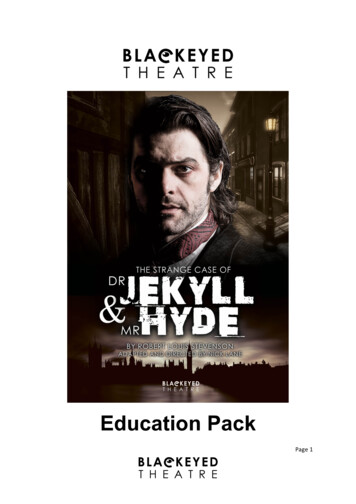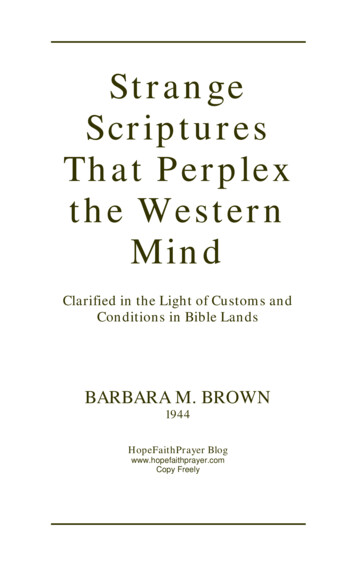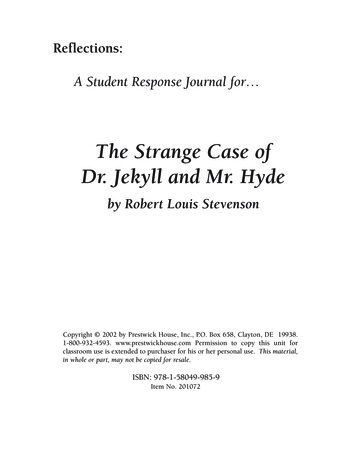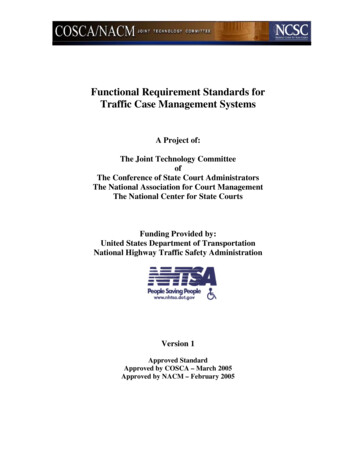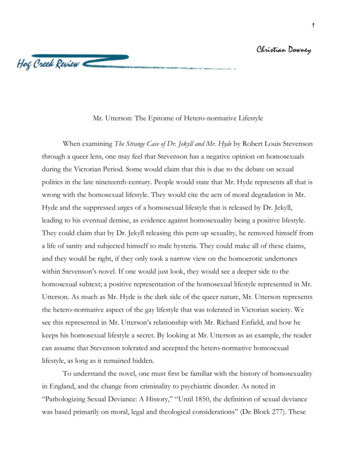
Transcription
1Christian DowneyMr. Utterson: The Epitome of Hetero-normative LifestyleWhen examining The Strange Case of Dr. Jekyll and Mr. Hyde by Robert Louis Stevensonthrough a queer lens, one may feel that Stevenson has a negative opinion on homosexualsduring the Victorian Period. Some would claim that this is due to the debate on sexualpolitics in the late nineteenth-century. People would state that Mr. Hyde represents all that iswrong with the homosexual lifestyle. They would cite the acts of moral degradation in Mr.Hyde and the suppressed urges of a homosexual lifestyle that is released by Dr. Jekyll,leading to his eventual demise, as evidence against homosexuality being a positive lifestyle.They could claim that by Dr. Jekyll releasing this pent-up sexuality, he removed himself froma life of sanity and subjected himself to male hysteria. They could make all of these claims,and they would be right, if they only took a narrow view on the homoerotic undertoneswithin Stevenson’s novel. If one would just look, they would see a deeper side to thehomosexual subtext; a positive representation of the homosexual lifestyle represented in Mr.Utterson. As much as Mr. Hyde is the dark side of the queer nature, Mr. Utterson representsthe hetero-normative aspect of the gay lifestyle that was tolerated in Victorian society. Wesee this represented in Mr. Utterson’s relationship with Mr. Richard Enfield, and how hekeeps his homosexual lifestyle a secret. By looking at Mr. Utterson as an example, the readercan assume that Stevenson tolerated and accepted the hetero-normative homosexuallifestyle, as long as it remained hidden.To understand the novel, one must first be familiar with the history of homosexualityin England, and the change from criminality to psychiatric disorder. As noted in“Pathologizing Sexual Deviance: A History,” “Until 1850, the definition of sexual deviancewas based primarily on moral, legal and theological considerations” (De Block 277). These
2legal considerations were a result of the criminalization of sodomy during the 17th and 18thcenturies. Along with acts of bestiality, men engaging in same-sex relations would besentenced to death, if the evidence brought against the defendants supported the crime. Thisview also spilled into the profession of psychiatry. Many doctors did not see a connectionbetween homosexuality and mental disorder because they believed that sexual deviants weremerely criminals. These doctors based their claims on the belief that homosexuals had freewill concerning same-sex relations (279).The medical profession began to change its view on the criminality of homosexualityin the 1860s. Instead of punishment, psychiatrists began searching for a cure for samegender sexual relations. Opposed to the belief that same gender sex was a disease of thegenitalia, psychiatrists felt the need to treat patients with psychology (279). This newpsychological treatment led to the creation of homosexuality as a medical term. According toMichael King and Annie Bartlett, Karoly Benkert first used the term homosexuality todescribe the act of same-sex relations in his book Homosexualitat in 1869. This text furtheredthe debate on whether homosexuality was a moral or mental issue. It was not until 1892,with the publishing of Krafft-Ebing’s Psychopathia Sexualis, that society accepted the notionthat homosexuality was a disease of the mind (107).As The Strange Case of Dr. Jekyll and Mr. Hyde began being written in September of1885 and was published in 1886, Stevenson would have been familiar with the debateconcerning the classification of homosexuality as a mental disorder (Stevenson 26).Throughout the novel, the reader can see hints of homoerotic text intermingled with themotif of mental disorder. We also begin to see the stigma homosexuality brings and the needfor secrecy, through the character Mr. Utterson. If one believes that Mr. Hyde is the outwardexpression of Dr. Jekyll’s repressed homosexuality, the reader can see the need for Mr.Utterson to hide his sexual nature from the world, as Mr. Hyde is the representation of allthat is bad in coming out with one’s sexuality. But first, the reader must understand that Mr.Utterson is also a homosexual.There are many statements within the novel to support the fact that Mr. Uttersonengages in same-sex relations. The first piece of text supporting this theory is:
3The geniality, as was the way of the man, was somewhat theatrical to the eye; but itreposed on genuine feeling. For these two were old friends, old mates both at schooland college, both thorough respecters of themselves and of each other, and, whatdoes not always follow, men who thoroughly enjoyed each other’s company. (38)This passage is a meeting between Mr. Utterson and Dr. Lanyon at the doctor’s home. Atfirst, the reader assumes that this is a meeting between old school friends. To understand thedeeper meaning, one must understand what took place amongst schoolmates in theseventeenth and eighteenth centuries. During this time, families within the higher social classsent their children to English boarding schools. As we can see by their professions of doctorand lawyer, both Mr. Utterson and Dr. Lyon would have belonged to this class of society. Asstated in Finding Out: An Introduction to LGBT Studies, “An active molly subculture developedin England during the eighteenth century . . . Male-male sexuality was thought to runrampant in boys’ schools and universities as well” (Meem 22). One would claim that thisactivity could be confined to the seventeenth-century. Upon further research, I found thatthis argument could be refuted. A person only needs to read Donald Hall’s history ofhomosexuality in Queer Theories. Hall bases his finding on the Victorian writer JohnAddington Symonds. When speaking of the nineteenth-century, Symonds claims, “same-sexerotic activity was rampant in boys’ boarding schools at mid-century” (33).With this new knowledge of homosexual practices in English schools, the reader canbegin to see the homosexual relationship that Dr. Lanyon and Mr. Utterson shared. With thephrases: “For these two were old friends, old mates both at school and college” and “menwho thoroughly enjoyed each other’s company,” a homoerotic subtext begins to emerge. Aswe see, Mr. Utterson and Dr. Lanyon not only attended primary school together, but theyalso spent their university years at the same school. This span of almost a decade would givethe two characters a chance to explore their sexual interests with each other. When thenarrator claims, “men who thoroughly enjoyed each other’s company,” the reader begins tosee that the characters are very close to one another. When you combine this “closeness”and the fact that they were “schoolmates,” it is not a far stretch of the imagination that thetwo characters were past lovers.
4We then see a repeat of these past school boy relationships when Mr. Utterson visitshis friend Dr. Jekyll. The narrator states, “Mr. Utterson so contrived that he remainedbehind after the others had departed. This was no new arrangement, but a thing that hadbefallen many scores of times . . . you could see by his looks that he [Dr. Jekyll] cherished forMr. Utterson a sincere and warm affection” (44). Through a queer lens, the reader can see aparallel between the relationship Mr. Utterson has with Dr. Lanyon and Dr. Jekyll. With theexclamation that Dr. Jekyll holds “a sincere and warm affection” for Mr. Utterson, thereader can assume that there is more than just a friendly bond between the two people. Thesimple act of Mr. Utterson remaining behind, until the others have left, makes the readerquestion the intentions of Mr. Utterson. We also see that this is an ongoing arrangement.The reader must ask himself/herself, what transpires during these secluded moments? Dothese men engage in some secret sexual tryst? We only have the context of this one meeting,which gives the reader no insight to the others. It is not until we look further into the textthat we find there is maybe more than meets the eye.The first sign of a deeper relationship between Mr. Utterson and Dr. Jekyll forms in afantasy concerning Mr. Hyde and Jekyll. In Mr. Utterson’s mind, he thinks:Or else he would see a room in a rich house, where his friend lay asleep, dreamingand smiling at his dreams; and then the door of that room would be opened, thecurtains of the bed plucked apart, the sleeper recalled, and lo ! there would stand byhis side a figure to whom power was given, and even at that dead hour, he must riseand do its bidding. The figure in these two phases haunted the lawyer all night. (39)First, Mr. Utterson fantasizing about Jekyll in bed is enough to question Mr. Utterson’ssexuality. No heterosexual male would admit to thinking such thoughts. Adding to thisimage is the graphic nature of the scene. Not only is Mr. Utterson dreaming about his malefriend in bed, but also Mr. Hyde entering. This entering reads as if it were straight from a gayor erotic novel or pornographic movie. The act of the bed curtains being pulled apart andthe “sleeper recalled” is very sensual in nature. Not only is the bed quite intimate, but alsothe curtains give the readers a sense of personal territory. This space is equivalent that of thearea around a person’s body, their personal space. To see this space being invaded furthers
5the sense of intimate relations about to happen. The narrator adds to this image by stating,“he must rise and do its bidding.” As the scene already sets a dark sexual tone, the readermay interpret this “bidding” as a dark sexual act. We see that Mr. Jekyll is a submissivepersonality giving in to any request the dominant Mr. Hyde dictates. Placing this dominanceover another in such an intimate setting creates an image of rough sexual intercourse, whereMr. Hyde is the master in the relationship.There is also a hint of jealousy concerning Dr. Jekyll by Mr. Utterson. Just prior tothe aforementioned action, the narrator speaks of the turmoil within Mr. Utterson’s mind.He states,“the great, dark bed on which he tossed to and fro, until the small hours of themorning began to grow large. It was a night of little ease to his toiling mind, toiling in meredarkness and besieged by questions” (39). With the phrases “tossed to and fro” and “histoiling mind,” the reader can picture the distress Mr. Utterson is under. As this distress leadsto the erotic dream, one must question how much is stress and how much is jealousy? AsMr. Utterson is lying in bed in the present, he also visions Jekyll in the same state, when Mr.Hyde enters. The reader can make a connection to the setting Mr. Utterson is in and that inwhich this homoerotic episode takes place. It is as if Utterson has a longing to be dominatedby Hyde, even though he is repulsed by Hyde’s character. This idea of submitting to Mr.Hyde further demonstrates the hidden homosexuality within the narrator.The final passage I wish to highlight concerning Mr. Utterson’s sexuality comes fromthe opening chapter of the novel. When describing Mr. Utterson, the narrator states, “In thischaracter, it was frequently his fortune to be the last reputable acquaintance and the lastgood influence in the lives of down-going men. And to such as these, so long as they cameabout his chambers, he never marked a shade of change in his demeanour” (31). On firstglance, one would just view this as part of Mr. Utterson’s profession as a lawyer. On aregular basis, he would be inclined to meet with those of less reputable morals and defendthem. It is the use of the word “chambers,” which can be viewed as a queer subtext.According to the Oxford English Dictionary, a chamber is, “A room or suite of rooms in ahouse, typically one allotted to the use of a particular person, a private room; (in later use)esp. a bedroom.” As Stevenson did not use the term “office,” or the like, the reader can see a
6more intimate setting, for the meeting. As these are “down-going men,” who lack morals,the reader would wonder in what types of services these criminals would engage in Mr.Utterson’s private rooms. As they have been invited into Utterson’s private lodgings, Ibelieve Mr. Utterson took full advantage of lack of character, and made them engage in hishidden sexual exploits, to procure his services as a lawyer.As we have explored the hidden lifestyle and urges of Mr. Utterson, we must nowexamine Utterson’s relationship with Mr. Enfield. We are first introduced to the couple’srelationship when it is stated that, “his [Mr. Utterson] affections, like the ivy, were thegrowth of time . . . Hence, no doubt, the bond that united him to Mr. Richard Enfield, hisdistant kinsman, the well-known man about town” (31). With the use of “affections” and“the bond that united,” to describe the relationship between Utterson and Enfield, thereader can picture a romantic involvement between the two characters. Although they were“kinsmen,” it was known in the nineteenth-century that homosexuality was hereditary.According to Chiara Beccalossi in her article titled “Nineteenth-Century EuropeanPsychiatry on Same-Sex Desires: Pathology, Abnormality, Normality and the Blurring ofBoundaries,” doctors understood the connection between heredity and mental disorders.This link between the diseases of the mind and heredity was also applied to sexual deviance(230). As both Mr. Utterson and Mr. Enfield are related, the idea that both would inherit thegene for homosexuality is plausible.We know that the two men spent much time together. We know this when thenarrator states, “in their Sunday walks . . . For all that, the two men put the greatest store bythese excursions, counted them the chief jewel of each week, and not only set asideoccasions of pleasure, but even resisted the calls of business, that they might enjoy themuninterrupted” (31-32). By the statement that these two men would not engage in anythingelse when scheduled to meet, we find that they will forsake all else to share each other’scompany. The act of walking together is also a form of class distinction. David Scobeyasserts, “Bourgeois New Yorkers of the Victorian era loved to promenade. Throughoutmost of the nineteenth century, they made seeing and being seen, in public and in motion, acore rite of sociability” (203). Although the author cites the locality of New York, I have
7found, through my participation in reenactments of English society during the Victorianperiod, that this was also the case with the London society. I have also learned that these“promenades” were primarily exclusive to people within a relationship and women, whentheir husbands were not around to escort them. This allowed others to see the standing insociety the couple shared (Tagatz n.p.). Applied to the situation with Mr. Utterson and Mr.Enfield, more evidence that the fellows had more than a typical friendship is discovered.It is on one of these walks that the couple encounters the door through which Mr.Hyde enters and leaves Dr. Jekyll’s residence. When viewing the surroundings, the couplepoints out that “Tramps slouched into the recess and struck matches on the panels” (32).Most readers would view this as an innocent observation, but there is more than meets theeye in this statement. One historian, Seth Koven, claims, “Victorian slumming, the codedreferences . . . to the upper- and middle-class fascination with the bodies of the poor”1 (qtd.in Reay 1:220-21). By Stevenson using the phrase “tramps,” we know that the people thecouple is viewing are poor and destitute. Although the “tramps” physical characteristics arenot described, we must give credence to the idea that Mr. Utterson and Mr. Enfield aresearching for the poor, to engage in “Victorian Slumming.”The question remains, why would males partake in the act of “Victorian Slumming?”Koven asserts that men of the Victorian Period would slum to acquire male prostitutes.Xavier Mayne furthers our understanding of this practice. He states, “although scarcelyvisible to the uninitiated, male prostitution in the large cities was as common as its femalecounterpart”2 (qtd. in Reay 2:221). This statement shows the way that Victorian menexercised sexual deviance. When applied to the novel, one can see that the walks that Enfieldand Utterson took were not only for leisure, but also to find men with whom they couldengage in sexual intercourse. Although the street on which they were walking was not a badsection of town, the reader also learns that the street that crosses the one they are on, whereDr. Jekyll’s front door is located, is a less desirable area of London. The fact that the twofellows notice the poor in Jekyll’s back doorway further accentuates the notion that they areS. Koven, Slumming: Sexual and Social Politics in Victorian London (Princeton, NJ, 2004), ch. 1.X. Mayne, The Intersexes: A History of Similisexualism as a Problem in Social Life. (New York, NY, 1975), pp. 426-42. Areprint of the original edition of 1908. Mayne’s real name was Edward Irenaeus Prime Stevenson.12
8on a mission of sexual deviance.With all the talk of immoral actions, many would feel that there is no way for Mr.Enfield and Mr. Utterson to have a hetero-normative lifestyle. Along with the couplewalking together, secrecy of their relationship is a large factor in creating a hetero-normativeimage. We see when Mr. Enfield states:“I feel very strongly about putting questions; it partakes too much of the style of theday of judgment. You start a question, and it’s like starting a stone. You sit quietly onthe top of a hill; and away the stone goes, starting others; and presently some blandold bird (the last you would have thought of) is knocked on the head in his own backgarden and the family have to change their name. No sir, I make it a rule of mine: themore it looks like Queer Street, the less I ask.” (35)Mr. Enfield is trying to convey that secrecy is paramount in anyone’s life. He is also claimingthat if one engages in gossip about another, it is not long before the tables are turned on thegossip. To keep his and Mr. Utterson’s relationship a secret, it is best to not discuss the lifeof others. With the term “day of judgment,” the reader also begins to sense a fear of theafterlife by Mr. Enfield. One can relate this fear to the religious idea that the couple’srelationship, although similar to a married couple, might condemn them to Hell. Because ofthis speech by Mr. Enfield, Utterson begins to see the need for secrecy and discretion andagrees with his partner.By this act of secrecy and all the homoerotic text, we can rightly assume thatStevenson condones homosexual relationships. Through my examination of The Strange Caseof Dr. Jekyll and Mr. Hyde, I have highlighted this with text and my interpretation. Althoughthere was debate on sexual politics in the late nineteenth-century, Stevenson has shown whatis right and wrong in the homosexual lifestyle. Yes, Mr. Hyde represents the moraldegradation of character, but only by the act of flaunting his sexuality. It is the deeper andsecret relationship, of Mr. Utterson and Mr. Enfield, which opens our eyes to the positiveaspects of living a hetero-normative lifestyle. This positive representation proves thatStevenson understands both sides of the debate. By creating such an upstanding character asUtterson, Stevenson was trying to convey to society homosexuality was not completely bad.
9In context with the period and the advances within the scope of psychiatry, the reader canfind Stevenson’s advice for discretion to the homosexual male. He would have known andunderstood how the medical field was beginning to classify homosexuality as a mentalillness. He would have known the laws surrounding those who engaged in its practice. Thereader can believe this novel was Stevenson’s way to inform the homosexual community thatthey needed to remain secretive. Although this homosexual subculture needed to remainunderground during this period, Stevenson gave homosexual males a positive role model tomimic in Mr. Utterson. Even today, it is not hard for gay males to find parallels betweentheir own experiences, and the ones of the characters in the novel. Although homosexualityis more publicly accepted, many of the same struggles in politics and society surround themodern gay subculture as it did in the Victorian Period. Just as it is now, it is nice to knowthere are supporters, such as Robert Stevenson.
10Works CitedBeccalossi, Chiara. "Nineteenth-century European psychiatry on same-sex desires:pathology, abnormality, normality and the blurring of boundaries." Psychology &Sexuality 1.3 (2010): 226-238. Print.De Block, Andreas and Pieter R. Adriaens. "Pathologizing Sexual Deviance: A History."Journal of Sex Research 50.3/4 (2013): 276-298. Print.Hall, Donald E. Queer Theories. New York: Palgrave Macmillan, 2003. Print.King, Michael and Annie Bartlett. "British Psychiatry and Homosexuality." The British Journaof Psychiatry 175 (1999): 106-113. Print.Meem, Deborah T., Michelle A. Gibson and Jonathan Alexander. Finding Out: An Introductionto LGBT Studies. Thousand Oaks, CA: Sage, 2009. Print.Oxford English Dictionary. "Chambers n." September 2013. Oxford English Dictionary Online.Web. 15 November 2013.Reay, Barry. "Writing the Modern Histories of Homosexual England." The Historical Journal52.1 (2009): 213-233. Print.Scobey, David. "Anatomy of the promenade: The politics of bourgeois sociability innineteenth‐century New York." Social History 17.2 (1992): 203-227. Print.Stevenson, Robert Louis. The Strange Case of Dr Jekyll and Mr Hyde. Ed. Martin A. Danahay.2nd. Toronto: Broadview, 2005. Print.Tagatz, Bob. "Lecture on Victorian Society and Manners at The Grand Hotel." MackinacIsland, October 2010. Lecture.
When examining The Strange Case of Dr. Jekyll and Mr. Hyde by Robert Louis Stevenson through a queer lens, one may feel that Stevenson has a negative opinion on homosexuals . in England, and the change from criminality to psychiatric disorder. As noted in "Pathologizing Sexual Deviance: A History," "Until 1850, the definition of sexual .



